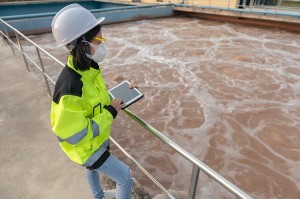A New Kind of Sewer-Hero
In 2020, at the start of the global COVID-19 pandemic, officials began testing wastewater for the virus. This tool soon helped officials track where the virus was spreading and whether cases were dropping in certain communities. What is wastewater and why is it used to track viruses? Wastewater comes from residential purposes such as bathing, laundry, and dishwashing. Most of the water in our homes is used to carry away wastes. This water, and the wastes it carries, is called sewage. Recently, scientists have employed this water for another purpose –virus tracking! It might not wear a cape, but it is helping officials prepare for outbreaks and provide information for residents on COVID-19, monkeypox, and polio. All three of these viruses are spreading in the United States.
In most U.S. cities, a piping system under the streets carries away the sewage from homes, factories, hotels, and other buildings. A system of pipes that carries sewage from buildings is called a sanitary sewerage system. Sewage has a bad odor. But more important, it contains disease-producing bacteria. Most cities have treatment plants that clean sewage water and kill the bacteria in it. The treated water can then be returned to a river, stream, or lake.
Almost all of the sewage in the United States undergoes some type of sewage treatment. Only a little of the sewage is dumped untreated into rivers. The dumping of untreated sewage causes serious problems for the environment and for cities downstream that take their water from the same rivers. Untreated sewage looks and smells foul, and it kills fish and aquatic plants.
Water treatment can also help scientists and disease experts track harmful viruses. Lately, officials have been testing wastewater for COVID-19, monkeypox, and polio. Officials are trying to control the spread of viruses to prevent epidemics. An epidemic is an outbreak of disease that attacks many people at about the same time. An epidemic may last a few hours, a few weeks, or many years. A disease that spreads throughout the world is pandemic. Public health agencies are responsible for the control of epidemics. Immunizations can prevent epidemics of some infectious diseases. Vaccines are available for COVID-19, monkeypox, and polio. Other epidemics are prevented by maintaining clean food and water supplies, or by controlling insects and other animals that spread disease. Informing people about the causes of epidemics and methods of prevention is crucial in the control of epidemics.
The next time you walk by a smelly sewer, remember not all heroes wear capes or smell good. When you see the case numbers or affected areas, tell your family and friends we have our wastewater and many dedicated scientists to thank!



